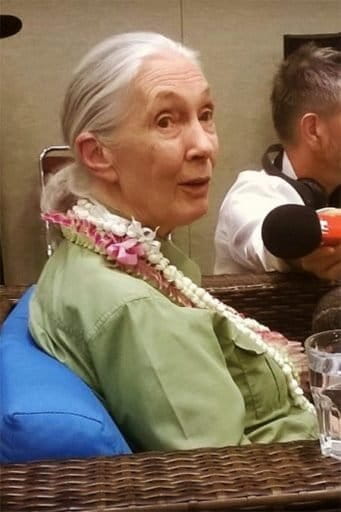Famed conservationist Jane Goodall, DBE, founder of the Jane Goodall Institute (JGI), UN Messenger of Peace, and Mongabay.com advisory board member visited Hawai’i last month for the World Conservation Congress, the International Union for the Conservation of Nature (IUCN)’s latest global gathering. She and her team kept a busy schedule as usual, giving press conferences and speaking about topics ranging from new conservation techniques to wildlife trafficking (she and her team travel an average of 300 days a year appearing at events, visiting school groups, and more).
Mongabay checked in with her briefly to continue the conversation and to hear her thoughts about progress made at the IUCN event.
AN INTERVIEW WITH JANE GOODALL
Mongabay.com: You spoke at the event about recent advances in conservation efforts around Gombe National Park, and now in nearby Uganda, thanks in part to technologies like 3D mapping. Are tech solutions coming to be as important as traditional conservation techniques in your view?

Goodall: I think, in view of additional pressures caused by human population growth and increasing demand for land for growing crops, and poaching, there is equal need for any tools that can help save the habitat, and chimpanzees’ lives. Traditional methods will always be important – it is absolutely necessary to have conservationists and/or researchers on the ground, to have people working with local communities, improving the lives of the people, encouraging sustainable livelihoods (tree nurseries, small family farms without the use of chemicals, and so on) and thus forming good relationships so that the villagers help in conservation of forests and animals. The use of satellite imagery, drones, and so forth make excellent ways of keeping track of what is going on. JGI has excellent relations with Esri, Google Earth, Digital Globe, and NASA. Help from these organizations is enabling us to develop the most advanced technologies in the fight to help wildlife, thanks to Dr. Lilian Pintea, Vice President of Conservation Science at JGI.
Mongabay.com: During your press conference, a reporter asked for your view of modern zoos, to which you replied that you’d rather be a chimpanzee in one of them vs. how they sometimes have to live in the wild. Can you say more?
Goodall: It’s just that I know so many places where chimpanzees must try to survive in forests that are being illegally logged, or logged by the big companies with permits. When chimpanzees try to move away, they are more than likely to encounter individuals of another community: as they are highly territorial, this means the interlopers will be attacked and such attacks often result in death. Moreover, hunters set wire snares for antelopes, pigs, etc, for food, and although the chimpanzees are strong enough to break the wire or pull a stake from the ground, the noose tightens around a hand or foot. Many individuals actually lose that hand or foot, or die of gangrene.
And then there is the bushmeat trade – the commercial hunting of animals for food. And the shooting of mothers to steal their infants for the illegal trade that has started up again as a result of a demand from China and other Asian countries and the UAE. Finally, as people move into the forests, they take disease with them, and chimpanzees, sharing more than 98% of our DNA, are susceptible to our contagious diseases.
Now think how the best zoos today not only have much larger enclosures, but well-qualified staff who not only understand but care about the chimpanzees, as individuals, and not just species. And great effort is put into enrichment activities, both mental and physical. Counteracting boredom is of utmost importance in ensuring a well-adjusted and “happy” group. This, of course, applies not only to chimpanzees, but all animals with even the slightest amount of intelligence. And we are learning more and more about animal intelligence all the time. The latest buzz is the octopus!
A final word: there is a mistaken belief that animals in their natural habitat are, by definition, better off. Not true, necessarily.

Mongabay.com: You had a great connection with the indigenous leaders present at the conference, do you see any points of potential collaboration between them and your own work?
Goodall: I have found that many indigenous leaders work very hard to conserve the environment and to try to protect their land from exploitation by especially oil and timber companies. In Latin America, many are fighting the oil companies – I spent some time with indigenous leaders in Ecuador, for example. The huge gathering of Native Americans protesting the pipeline that is planned to go through Lakota lands at Standing Rock – I have added my voice to theirs. The same with various developments in Canada.
Also, I was fascinated by the connection to the forest and its animal and plant life in the group of Batwa pygmies I encountered in the Republic of Congo, in the Goualougo Triangle. They knew all about tool using, diet, and so forth of the chimpanzees.
Mongabay.com: You’re known for your great optimism, so following the congress, have your feelings of hope for the future increased?
Goodall: I believe there is far greater understanding among people in many countries and different walks of life about the very desperate situation of the environment and wildlife in so many places, and for so many reasons. A great deal of networking went on during the IUCN meeting, and many new relationships will greatly benefit conservation efforts.
But despite this, there was growing understanding among the delegates of the magnitude of the problems we face in our efforts to protect environments and wildlife.
Hear more of Jane Goodall’s thoughts on animals in captivity following the troubling case of Harambe the gorilla here, and learn more about her work at the Jane Goodall Institute website.
